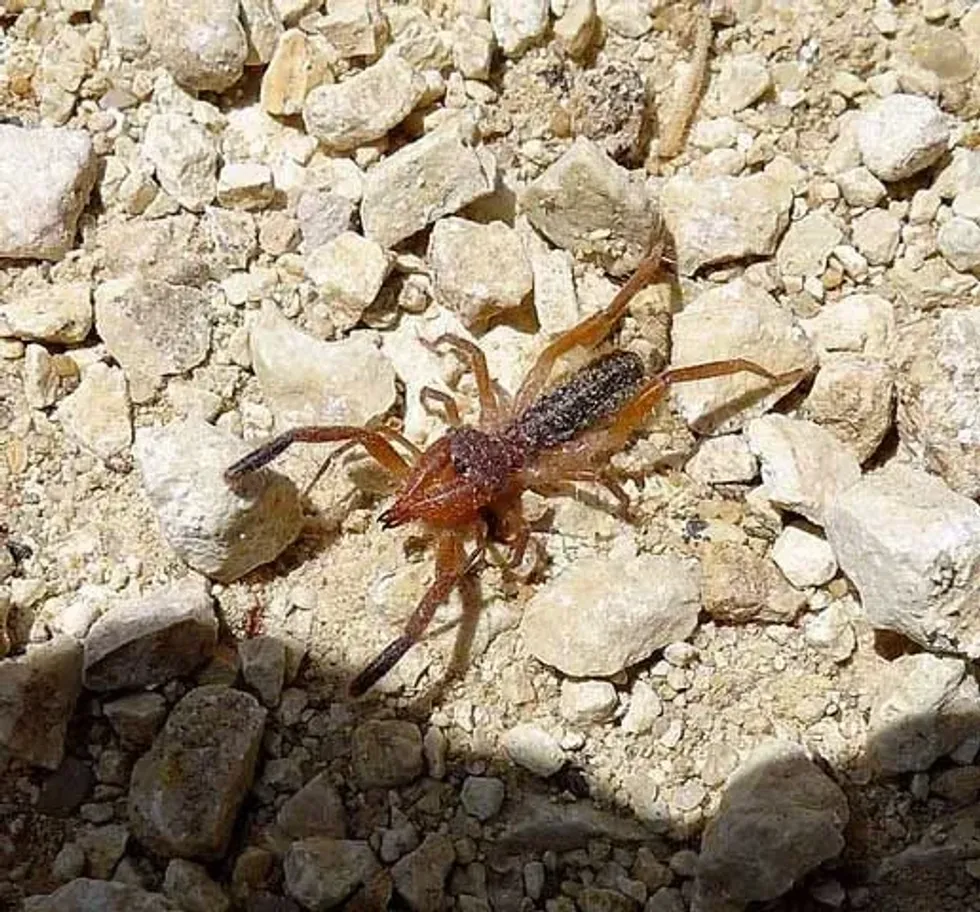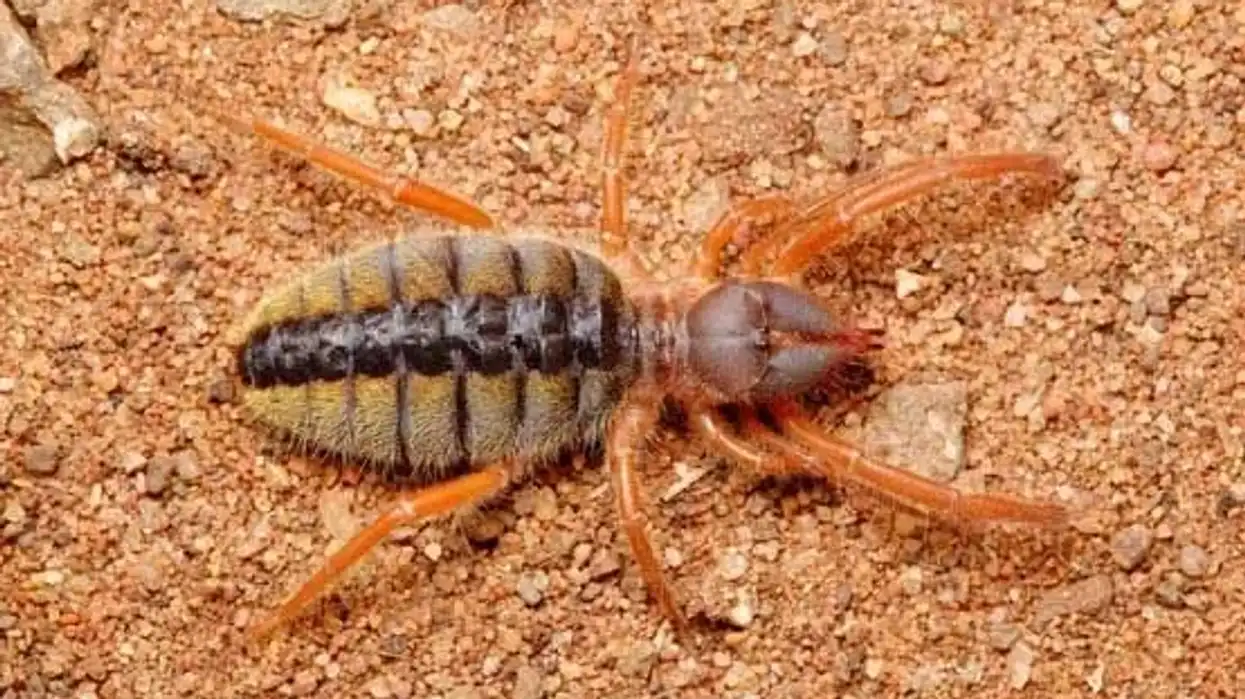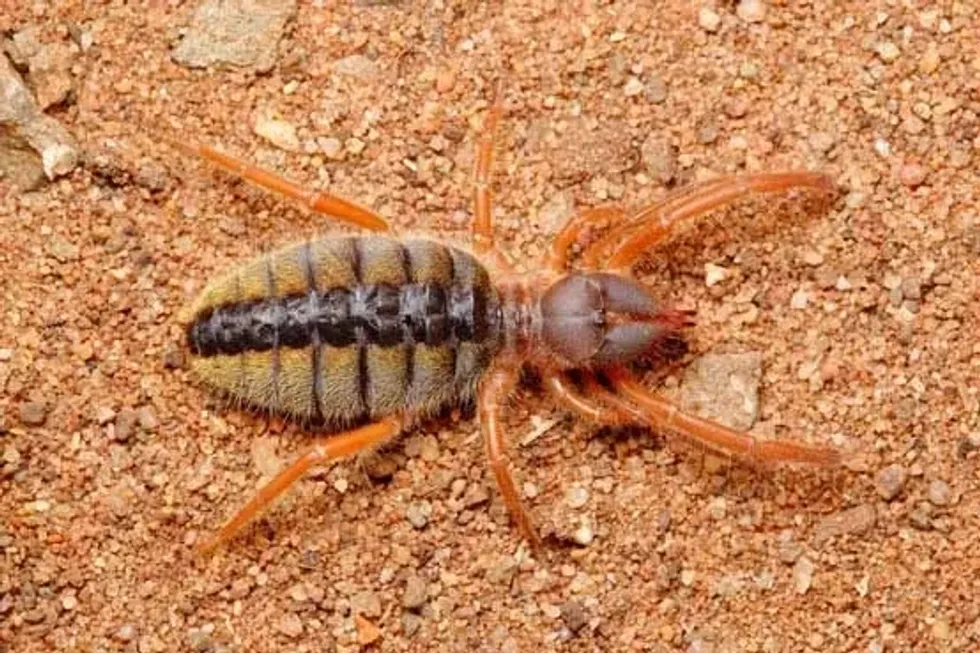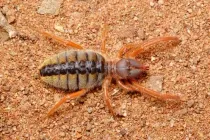Fun Camel Spider Facts For Kids

Camel spiders are also known as wind scorpions, sun spiders, and giant Egyptian solpugids. They are a group of over 1000 sub-species of spiders found all over the world except Australia and Antarctica.
They are more properly known as solifuges as they belong to the order Solifugae of class Arachnida. They are not true spiders but belong to the arachnids group.
They are solitary, nocturnal predators and hide away from the sun under rocks or shades. They are quite large spiders growing up to 6 in (15 cm) long in some species. They are uniquely identified by their extended chelicerae and pedipalps and they use their jaws to hunt small animals and insects, especially ants.
These spiders cannot spin webs, and so most species are unable to climb vertically up a wall. These camel spiders are spotted all over the United States especially in southwest California.
To know more about these huge spiders, please keep reading. If you like reading about various insects, then please check out our articles on mouse spider and wolf spider.
Camel Spider Interesting Facts
What type of animal is a camel spider?
Camel spiders are believed to be a type of spider but in a few places in the Middle East, they are referred to as wind scorpions or sun spiders.
What class of animal does a camel spider belong to?
A camel spider belongs to the Arachnida class.
How many camel spiders are there in the world?
There are over 1100 documented species of camel spiders and even though they are quite common throughout the world, they are heavily understudied which is why their exact population is not known.
Where does a camel spider live?
Camel spiders belong to the elusive order Solifugae. These spiders have over 1100 species most of which have not been studied due to a lack of research.
Camel spiders are commonly spotted in deserts all over the world and on all continents except for Antarctica and Australia. In the Middle East, they are often called a wind scorpion or a sun spider. These spiders are also spotted in the southwest of the United States and in Mexico.
What is a camel spider's habitat?
Camel spiders are more properly called solifugids as they are from order Solifugae. 'Solifugae' means to 'flee from the sun'.
These spiders prefer living in dry habitats like deserts or scrublands but during the day, they flee or run away from direct sunlight in search of shadows or shade to rest until sundown. Camel spiders are nocturnal predators. During the day, they look for shade to hide and once the sun goes down they set out for their prey.
Unlike most spiders, they lack spinnerets and silk, so they can't spin a web. They take shelter by burrowing underground in cool sand to hide from their predators.
Who do camel spiders live with?
All known camel spider species are known to be solitary predators or they hunt alone, except for mating season. During the breeding season, a male camel spider will chase a female camel spider to mate and reproduce before its short life comes to an end.
How long does a camel spider live?
Most camel spiders, unlike most arachnids, have an average lifespan of up to one year. They are hunted by small birds, toads, bats, reptiles, and other larger insects.
How do they reproduce?
Like most arachnids, a male camel spider chases a female in order to mate. Once the mating process is over and after an 11 day gestation period, females dig a burrow and lay about 50 to 200 eggs on average at once.
A female camel spider stores energy in the form of fat as she won't leave the burrow until the eggs have hatched.
In a lot of cases when a female has not been able to store enough food for herself, she will die protecting her eggs. It takes about three to four weeks for the eggs to hatch.
What is their conservation status?
A camel spider is listed as Not Evaluated by the International Union for Conservation of Nature (IUCN) Red List of Threatened Species. Even though there are over 1000 species of order Solifugae, most of them are heavily understudied and still undocumented.
Camel Spider Fun Facts
What do camel spiders look like?
Camel spiders have over 1000 subspecies of order Solifugae. These arachnids mostly look alike and are found in colors such as tan and dark brown or brown with a hairy body to blend into a dark, dry environment and to regulate their body temperature.
They have a pair of extended appendages or two extended pedipalps which function as their forelimbs and help them catch and pull their prey towards their strong jaws or the chelicerae.
These are non-venomous spiders so their hunting technique solely depends on their physical attributes.
The camel spider species has a body length up to 6 in (15 cm) and weighs within 2 oz (57 g) which is about the weight of a tennis ball. These animals are also well known for their predatory skills which involves a camel spider running after its prey or away from the sun.

How cute are they?
The camel spider is the common name for Solifugae and is a solitary predator non-venomous desert spider. These are dangerous and aggressive predators who prey on other small insects or invertebrates.
Even though they don't pose any real threat to humans, they can't be considered cute at all. These scary-looking desert spider species are not even true spiders.
They are regarded as wind scorpions in the Middle East but aren't true scorpions either as they belong to the Arachnid family of animals. The pair of pedipalps with unusually long chelicerae in the front make them look like they have 10 legs instead of eight.
They have very strong jaws, also called chelicerae, to kill their prey with a bite or two. They don't have any venom but a camel spider bite could be quite painful.
How do they communicate?
Spiders or arachnids are known to communicate through vibrations and the language of all spiders is called Spydric. They use various levels of vibrations to communicate with other spiders about courting, warning the rival, and catching prey. This type of communication through vibration is called seismic communication. All spiders are known to communicate via this method including camel spiders.
How big can a camel spider get?
Camel spiders are actually a large group of spiders more properly known as solifugae with eight legs for movement and two extended pedipalps to help them capture prey. These desert native spiders are quite big, bigger than most spider species and sub-species.
A giant camel spider grows up to 6 in (15 cm) long and weighs around 1-2 oz (30-56 g).
A typical camel spider size depends on the sub-species and females are bigger in most species. When compared to an adult cockroach, a camel spider is bigger in size.
How fast can a camel spider run?
Camel spiders are one of the fastest spider species in the Solifugae order. These desert spider species can easily maneuver through the hot loose sandy soil of the desert quite easily.
A camel spider has been known to run at a top speed of 10 mph (16 kph) approximately.
They use their eight legs to move from one place to another and use their pair of pedipalps and chelicerae to capture prey. They use their chelicerae as jaws that move against each other to grind the prey to make the food easier to digest.
How much does a camel spider weigh?
Camel spiders weigh as much as a tennis ball. There are above 1000 sub-species and all of them weigh within the range of 1-2 oz (30-56 g). Their body length and weight vary from one species to another but all documented species abide by the range.
What are their male and female names of the species?
There are no separate names for males and females among the arachnids and the same applies for camel spiders as well. A female camel spider is usually much larger in size than its male counterpart, whereas males have longer legs. To differentiate among camel spiders, females have epigynum and males have a pair of pedipalps.
What would you call a baby camel spider?
Like all spider babies, a camel spider baby is called a 'spiderling'. Spiderlings look exactly like their parents, except much smaller in size and they immediately disperse away by crawling as soon as they hatch out. This behavior is patent among the class Arachnida and is called 'blooming'.
What do they eat?
Camel spiders are carnivores and aggressive predators in nature. Their diet includes quite a variety of animals and insects such as small birds, lizards, beetles, small baby snakes, termites, and gerbils.
They use their unusually long chelicerae which act like extended jaws to hold their prey. They use their digestive juices to turn their prey into a pulpy liquid. This makes it easier for them to consume.
Since these spiders are native to deserts and scrublands, the availability of food is scarce so they store energy in the form of fat in their bodies. This has led to their most common name, camel spiders.
Are they poisonous?
No, the camel spider species is not even slightly venomous. These spiders of class Arachnida have a lot of names like wind scorpions, sun spiders, and fiant Egyptian solpugid.
They have been subjected to several myths and legends. In reality, these spiders pose no threat to humans at all and they only follow humans to cool themselves under our shadow, not because they want to bite us.
Their bite is not fatal but very painful and leaves a significant wound on human skin and can become infectious due to an open wound. Swelling and mild or intense bleeding have been noticed after the bite.
Camel spiders are very popular for preying on soldier ants in particular as they guard the pupae and the eggs. These pupae and eggs are savory for camel spiders as they are super soft, squishy, and rich in protein and fat.
Would they make a good pet?
No, unfortunately, camel spiders don't do well in captivity and they are nocturnal predators, so keeping them as pets is next to impossible and not recommended. Even though they are not poisonous, they have a painful bite.
They are aggressive predators who prefer dry, hot deserts to live in. They also flee away from the sun by hiding under rocks to protect themselves from the intense desert heat.
They have been hard to study because of their nature of fleeing away from labs and these spiders are fast. A camel spider's bite is so strong that it could possibly kill a small dog as its bite is poisonous for animals but not humans.
Did you know...
There are several legends about camel spiders that have been circulating for years and spread rumors about this spider. Some of these myths go back centuries. The fact that camel spiders feast on camel flesh is a complete myth. This myth came from Iraq after the war when an Iraqi camel spider had bitten soldiers.
What sound do camel spiders make?
Contrary to popular myths that a camel spider screams while chasing its prey or a human, the sound of a camel spider actually comes from their habit of stridulation (rubbing two body parts together to produce a sound). A camel spider's stridulation sounds like a hissing or a buzzing and doesn't even come close to a scream.
A camel spider scream is a complete myth.
How does a camel spider bite?
Camel spiders use their strong jaws chelicerae to kill their prey. They are capable of killing their prey with two bites. Although their bites are not venomous, they can be pretty painful.
Here at Kidadl, we have carefully created lots of interesting family-friendly animal facts for everyone to discover! Learn more about some other arthropods including Brazilian wandering spider, or green crab.
You can even occupy yourself at home by drawing one on our Camel spider coloring pages.
We Want Your Photos!
More for You
Bachelor of Arts specializing in Journalism and Mass Communication, Postgraduate Diploma in Sports Management

Moumita DuttaBachelor of Arts specializing in Journalism and Mass Communication, Postgraduate Diploma in Sports Management
A content writer and editor with a passion for sports, Moumita has honed her skills in producing compelling match reports and stories about sporting heroes. She holds a degree in Journalism and Mass Communication from the Indian Institute of Social Welfare and Business Management, Calcutta University, alongside a postgraduate diploma in Sports Management.
Bachelor of Business Management specializing in Financial Management

Sapna SinhaBachelor of Business Management specializing in Financial Management
Sapna has a Bachelor's degree in Business Administration from Poornima University, Rajasthan. She has writing experience from working for a news agency as a writer, interning at various companies, and writing and editing articles on education.
Disclaimer
1) Kidadl is independent and to make our service free to you the reader we are supported by advertising. We hope you love our recommendations for products and services! What we suggest is selected independently by the Kidadl team. If you purchase using the Buy Now button we may earn a small commission. This does not influence our choices. Prices are correct and items are available at the time the article was published but we cannot guarantee that on the time of reading. Please note that Kidadl is a participant in the Amazon Services LLC Associates Program, an affiliate advertising program designed to provide a means for sites to earn advertising fees by advertising and linking to Amazon. We also link to other websites, but are not responsible for their content.
2) At Kidadl, we strive to recommend the very best activities and events. We will always aim to give you accurate information at the date of publication - however, information does change, so it’s important you do your own research, double-check and make the decision that is right for your family. We recognise that not all activities and ideas are appropriate for all children and families or in all circumstances. Our recommended activities are based on age but these are a guide. We recommend that these ideas are used as inspiration, that ideas are undertaken with appropriate adult supervision, and that each adult uses their own discretion and knowledge of their children to consider the safety and suitability. Kidadl cannot accept liability for the execution of these ideas, and parental supervision is advised at all times, as safety is paramount. Anyone using the information provided by Kidadl does so at their own risk and we can not accept liability if things go wrong.
3) Because we are an educational resource, we have quotes and facts about a range of historical and modern figures. We do not endorse the actions of or rhetoric of all the people included in these collections, but we think they are important for growing minds to learn about under the guidance of parents or guardians.







